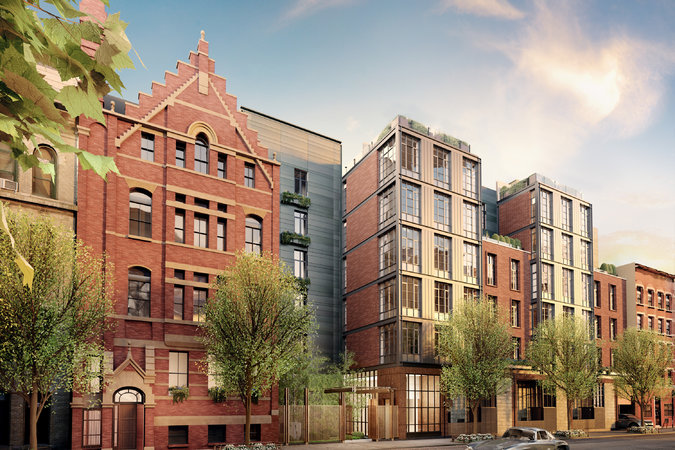By C. J. Hughes
Greenwich Village is known for its corner cafes and doglegs of streets. But in recent years, it’s been associated with something that doesn’t wind up in too many guidebooks: divisive development projects.
Whether they involve expanding universities or shuttering hospitals, these plans have sparked heated battles about the pace and scale of change, in a place that cherishes its history.
A new condominium at 215 Sullivan Street hasn’t done much to reverse the image that the Village is locked in a development-versus-preservation brawl: The 25-unit project is replacing a popular school run by the Children’s Aid Society that served the area for more than a century.
But while Broad Street Development, which is building the condo, may be depriving the community of an affordable nursery school, the company has come with an olive branch of sorts, namely a design intended to complement the area’s low-slung, brick-face look.
“We wanted something to be proud of, and we wanted to respect the neighborhood,” said Raymond E. Chalme, the chief executive of Broad Street. “I think people will appreciate the whole feeling of the project.”
The $83 million complex includes buildings that are no taller than six stories, even though zoning would have permitted a 14-story tower on the site, Mr. Chalme said.
And though he razed most of the school facilities, including a playground and theater, Mr. Chalme kept one building, a russet neo-Gothic structure that Calvert Vaux, a creator of Central Park, designed with George Radford in 1892. He was not forced to preserve the building — between Bleecker Street and West Third Street — because a historic district was formed there last December, after the project already had its building permits in place.
Broad Street is also trying to add some historical context. A triangular front gable will gain stepped edges, to bring it in line with the original. A slate roof will replace shingles, and bricks that were removed from the southern facade and interior walls will be reused in the gable, Mr. Chalme said. Of course, a revived antique can have powerful curb appeal, too. In fact, the priciest apartment at 215 Sullivan will be a duplex across the bottom two floors of the Vaux building. The six-bedroom unit will have nearly 7,000 square feet of interior space, plus another 2,000 square feet of outdoor space and will be priced at around $18 million.
But the project isn’t totally retro. Renderings show some apartments will be tucked inside steel-and-glass sections, and a zinc wall forms the backdrop for an entry garden and its fountain.
Prices, which will range from about $2,500 to $3,500 a square foot, may not set records for the neighborhood when sales start in March, said Fredrik Eklund, a broker with Douglas Elliman Real Estate who is on the project’s sales team. The Greenwich Lane, a nearby condominium complex rising from the site of the former St. Vincent’s Hospital has asking prices that average $3,500 a square foot. “This development could have been a lot worse, aesthetically,” said Andrew Berman, the executive director of the Greenwich Village Society for Historic Preservation, which organized a rally at 215 Sullivan site in 2011, after it was sold to Broad Street for $33 million, to spur the city to create a protective historic district there.
“On the other hand, the loss of an institution like the Children’s Aid Society is a real blow to the neighborhood,” Mr. Berman said.
When the Children’s Aid Society sold the site, it left the Village. The residents the group was created to serve, many of them poor Italian immigrants, had dwindled in number and had been replaced by a more affluent crowd.
Signs of gentrification are indeed evident. At Peanut Butter and Company, a restaurant at No. 240, peanut-butter-and-jelly sandwiches sell for $5.75. At No. 208 is the Sullivan Street Tea and Spice Company, where a customer on a recent evening came in looking for Lapsang souchong tea to brew in equipment worth $20,000.
Tara Sussman, a store manager, said her customers often criticized the closing of the school, but she sensed that anger was ebbing. “They’ve accepted their fate,” she said, “which is how it always seems to kind of happen in New York.”
